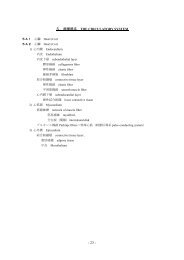Program / Abstract Book - KMU WWW3 Server for Education ...
Program / Abstract Book - KMU WWW3 Server for Education ...
Program / Abstract Book - KMU WWW3 Server for Education ...
You also want an ePaper? Increase the reach of your titles
YUMPU automatically turns print PDFs into web optimized ePapers that Google loves.
PLEX-ID Technology as a Single Tool <strong>for</strong> the Detection and Typing of Microbiological<br />
Infections in Immuno-Compromised Patients<br />
Jérôme Le Goff 1 , Linda Feghoul 1 , Jean Menotti 1 , Jean Luc Donay 1 , Séverine Mercier-Delarue 1 ,<br />
Jean Louis Pons 1 , Marcus Picard-Maureau² and François Simon 1<br />
1- Université Paris-Diderot, Hôpital Saint-Louis, Paris, France<br />
2- Abbott Ibis Biosciences, 65205 Wiesbaden, Germany<br />
Introduction : the PLEX-ID technology (Abbott Ibis Biosciences), combining broad-range multiwell<br />
PCR and mass spectrometry enables the detection and identification of a large spectrum of pathogens in<br />
a single test. The PLEX-ID analysis is based on a broad multiwell PCR followed by an electrospray<br />
ionization of the generated amplicons to analyse their time of flight by mass spectrometry. The weight<br />
of the amplicons allows to determine their base compositions. The PLEX-ID technology allows to<br />
identify large a variety of pathogens from various sample types (blood, plasma, biopsy, CSF, BAL..) in a<br />
few hours, enabling the resolution of mixtures and according to the assay, a high resolution in<br />
genotyping. A large panel of assays is available, from public health and biothreat to medical diagnostics.<br />
That integrated solution allows the analysis of up to 15 x 96-well plates over 12 hours <strong>for</strong> a total<br />
throughput of up to 250 samples per day.<br />
We evaluated in our university hospital, specialized in Hematopoietic stem cells (HSC) and kidney<br />
transplants, the per<strong>for</strong>mances and reliability of the PLEX-ID technology.<br />
Objectives : to compare the accuracy and the rate of infections detected by PLEX-ID clinical assays and<br />
routine standard methods and to compare the turnaround times of both procedures.<br />
Methods : We evaluated 3 different clinical PLEX-ID assays <strong>for</strong> medical microbiology.<br />
- The Viral IC assay detects 174 RNA and DNA viruses species and 2611 subspecies. We first analyzed<br />
275 frozen samples from 54 children and 11 adults infected with Adv (245) and from non-infected<br />
patients (30). In a second study, we parallelized the routine vs PLEX-ID in 79 fresh samples from HSC<br />
and kidney transplants.<br />
- The BAC Detection assay identifies 6026 species of bacteria and Candida and 4 antibiotic<br />
resistance markers ( kpc, mec A, van A, van B). Peripheral blood and catheter sampling were tested in<br />
BACT Alert blood culture (bioMérieux) and PLEX-ID. Preliminary study included 48 samples from<br />
adult patients.<br />
- The Broad Fungal assay identifies 2108 species. Fresh broncho-alveolar lavages and nasopharyngal<br />
aspirates from 25 patients were compared between fungal culture and PLEX-ID analysis.<br />
Additional samples collected from patients with undiagnosed fever were included in the BAC and<br />
Fungal studies.<br />
Results : All the negative PLEX-ID results in clinical samples were negative in the routine procedure<br />
considered as the gold standard, pointing the excellent PLEX-ID negative predictive value. A high<br />
negative predictive value was also observed with stored plasma samples in Viral IC assay.<br />
- Viral IC assay in Adenovirus-infected patients: ADV was detected in 96.4% of ADV positive stored<br />
plasma. The accuracy <strong>for</strong> species identification was 0.985. Out of 29 routine-negative samples collected<br />
from known ADV infected patients, 7 were positive with PLEX-ID. Viral loads determined with<br />
- 33 -



